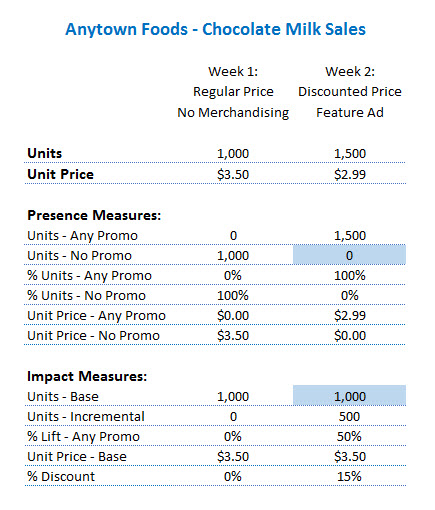 In my last post, I laid out how Nielsen/IRI define each promotion condition they measure. Today I’ll tackle the difference between promotion presence measures and promotion impact measures. Understanding this distinction will help you sort through the long list of promotion facts and avoid common errors.
In my last post, I laid out how Nielsen/IRI define each promotion condition they measure. Today I’ll tackle the difference between promotion presence measures and promotion impact measures. Understanding this distinction will help you sort through the long list of promotion facts and avoid common errors.
In brief, presence measures tell you how much and what type of promotion you received. Impact measures tell you whether those promotions increased your sales.
Here are a few example measures for each category:

Presence measures are relatively straightforward – Nielsen/IRI simply track and record the merchandising conditions. If the product sells when there’s a TPR, a retailer feature and/or a secondary display, then that sale counts as a promoted sale. If no promotions are present, then the sale counts as a non-promoted sale.
Impact measures are more complex – they require estimation and rely on historical data. To provide impact measures, IRI and Nielsen must estimate base volume. Base volume tells you what your sales would have been if there had been no promotion. I’ll share more details about how base volume is estimated in future posts.
Once Nielsen/IRI estimate base volume, they compare it to actual total volume, and the difference is incremental volume:
Total Volume – Base Volume = Incremental Volume
Have your managers asked you the common question: “What would sales have been without that promotion?” You have to look at base sales. Non-promoted sales will give you the wrong answer. Here’s a simple example to demonstrate why:
Let’s say you sell chocolate milk. Last week, Anytown Foods sold your product at regular price. This week, they discounted the price of your chocolate milk in every store and featured it in the retailer’s in-store circular. Your sales go up! IRI/Nielsen report:

Let’s go back to our question: “What would sales have been without that promotion?” We look at Week 2 (the promotion week). Non-promoted sales (Units – No Promo) are 0. Because every store had the product on promotion, there are no non-promoted sales. See why this is not the right measure to use when answering this question?
Although the difference between non-promoted sales and base sales is clear in our simple example, it becomes harder to spot when looking at data for a whole market over a longer period of time. Just remember that promoted and non-promoted sales don’t give an accurate picture of what would have happened without the promotion. Only incremental and base sales do that job.
Need help getting started with trade promotion evaluation? Contact us to learn more about our consulting services. We provide analysis, custom training, and report development.
Did you find this article useful? Subscribe to CPG Data Tip Sheet to get future posts delivered to your email in-box. We publish articles twice a month. We will not share your email address with anyone.

Hello,
Firstly, you are the source for all things Nielsen! I am an eCommerce Account Manager that is looking to gain insight into the world of Nielsen reporting for B&M, you’re pages have help a ton!
What does it mean when incremental volume is negative?
What time frame should most data be viewed through? I have weekly data from 11/09/2013 through 10/17/15. Should I aggregate it by month, year or simply sum it? Currently working with the Base Vol, Incr Vol, Avg Price Per Unit, Any Promo Unit Price, Non Promo Price Per Unit.
Dear Jeremy,
Here is a post that explains negative incremental volume.
If you want to know more, after that, this post would be the next one to read.
Optimal time period depends on what you are trying to learn. Individual promotions might need to be analyzed at the weekly level. An assessment of overall trade promotion efficiency would best be done using a longer period.
This article is extremely helpful on this topic- huge thanks.
One question – normally, will IRI/Nielsen provide directly base line data ?
Yes, in the US base sales are usually available in your database. Sometimes to save money companies choose a lower level of facts that do not include base and incremental but only non-promoted and promoted sales. Base sales are available in some other countries as well.
Hi,
This blog is truly amazing. Thank you so much 🙂
In blog it’s been written that- ”
I’ll share more details about how base volume is estimated in future posts.” Is this post is been published ?
I was looking for the way to calculate/estimate it in my current project.
Why?
Well, in project I want to know if an NPD / new product launch is adding incremental value to a category, and not just replacing the sales of the product it replaced (or if there was no discontinuation, that it’s not just cannibalising the existing products or “moving sales around the store”!)
However the new product launches (or can be at any time) on promotion, so I want to see if any category uplift is due to the NPD actually adding incremental sales (eg. it’s filling a gap), or if the uplift is due to a promotion (which I might have seen by simply promoting the existing products)…
Note in my data set, I don’t have baseline 🙁 . (Luckly, I have past sales data of existing products )
2nd note – I also don’t have info about promotion
I guess, by getting baseline, I will be able to get incrementality. (Pl correct me if I am incorrect)
It will be great to have your thoughts on this.
(help me with link if blog is already been written)
Sumeet
Sumeet,
I think the post that article refers to is this post.
Another series of posts that might help you, as you wrestle with this question, starts here. This series of posts is not about incremental volume but might help you think about your question in useful ways.
Your underlying question is a complicated one and it doesn’t sound like you have a lot to work with (you say you don’t have information about promotion). Doing the kind of analysis you are thinking of often requires detailed causal data and some statistical modelling. Here are a few tips though that might be helpful: If you have weekly data, you could look at sales for existing products and you might be able to see when the promotions occurred and get an idea of typical category lift due to promotion. Then you could compare that to category lift you see with the new product intro. If that works, you will be lucky because often (usually!) there is too much else going on to do this type of simple analysis but it never hurts to try.
If the retailer ran an EDLP for couple of weeks, the correct representation of the performance of EDLP volume would reflect in Base or No Promo?
“EDLP for a couple of weeks” isn’t really EDLP, which means Every Day Low Price. If the event runs for 2 weeks, then you should evaluate the performance looking at incremental volume and lift. If the retailer runs an EDLP strategy for the brand then total volume is the best measure. If they are EDLP but have your brand on Display for up to 7 weeks, then incremental and lift are the key measures of performance.
Are there any Trade Efficiency/ROI metrics that we can calculate that ties in the amount we spent on the promotion?
Possibly something like: Dollars of lift/Dollars spend on the promotion
If yes, I’m assuming higher number = more efficient?
Yes! Any measures that relate to spending must be calculated and are not available directly in your Nielsen/IRI/SPINS database. You may see a measure called something like “Merchandising Efficiency” in a syndicated database but that is incremental sales/promoted sales and does not take into account spending.
The hardest part of calculating Trade ROI is determining how much was spent on any given promotion, in terms if item(s), store(s) and time period. You are right that higher is better with this. Two common ways of looking at it are:
1. incremental $ / trade $ spent, which tells you revenue per dollar spent
2. incorporate your profit margin, so incremental profit $ / trade $ spent
I’d be happy to discuss this further if you’d like – please fill out the Contact form here and we can set up a call.
Hi !!!!
Manually calculated %Dollar lift with base sales and incremental sales is different from data tool generated % dollar lift. The formula used is : (Incremental sales/Base sales)X100. I am perplexed by this. Time period is 52 weeks. Do data companies adjust %Dollar lift for longer time periods?
That formula is the correct formula and, in my experience, the one used by Nielsen and IRI.
You don’t say what your “data tool” is. If it’s not Nielsen/IRI software, perhaps a different formula *is* being used.
Another possibility is that the promotion conditions for the % lift calculation doesn’t match. For example, perhaps when you are making your manual calculation you are using total base and total incremental sales for all weeks BUT the data tool lift value is for the “Any Promotion” condition. If so, those % lift numbers won’t match.
I don’t understand the last part of your question regarding % lift for longer time periods. If you want to reply and clarify the question, I’ll try to give you an answer.
First of all your posts are super helpful to understand soo many concepts. I am looking for a way to flag promotional weeks in my data in case I do not have Any_promo column. Is there a way to analytically flag promotional week just by using Total Units ?
I’m glad you’re finding the CPG Data Tip Sheet so useful! If your database does not have “Any Promo” or “Any Merch” facts then, unfortunately, there’s really no way to flag promotional weeks just using Total Units. Whether sales are promoted or not is determined at the store level, which is not available in most client databases. I guess at the banner/retailer-PPG/item-weekly level you might be able to tell there was a promotion if sales are noticeably higher than “usual,” however you decide what that is. But at any aggregated level of stores, items and weeks you can’t “back into” promoted weeks.